Paleo 203 Final
0.0(0)
0.0(0)
Card Sorting
1/182
Earn XP
Description and Tags
Study Analytics
Name | Mastery | Learn | Test | Matching | Spaced |
|---|
No study sessions yet.
183 Terms
1
New cards
Sauropterygia (informally, sauropterygians)
A group of aquatic diapsids best known for their most derived memebers- the plesiosaurs. Name means "winged lizard" in reference to their four large wing-like flippers. Fully aquatic by the end of the Triassic, extinct during end-Cretaceous
2
New cards
Lower temporal bar
a segment of bone that forms the bottom edge of the lower temporal fenestra.
3
New cards
Polytomy
A node in a phylogenetic tree that leads to more than two branches. Sauropterygians could be in lepidomorpha or related to archosauromorpha
4
New cards
Scapula
The technical term for the shoulder blade.
5
New cards
Dorsal
The back, or upper side, of an organism.
6
New cards
Clavicle
The technical term for the collar bone.
7
New cards
Ventral
The abdominal, or under side, of an organism.
8
New cards
Sauropterygian Skull
Defended from diapsids, modified euryapsids, lost temporal bar means a whole is still present but its not a fenestrae
9
New cards
The 5 Sauropterygian Clades
Placodontia, pachypleurosauria, nothosauria, pistosauria, pleasiosaurs
10
New cards
Sauropterygian Pectoral Girdle
All bones located on the ventral side of the body, plate like scapula overlaps the clavicle, increased muscle attachment
11
New cards

Placodontia (informally, placodonts)
A group of durophagous Triassic marine reptiles. There were two major grous: the Placodontoids and the Cyamodontoids. “Plate teeth” flat plate on mouth roof with protruding front teeth, paddled in shallow water, webbed feet or less developed paddles, appendicular loccomotion
12
New cards
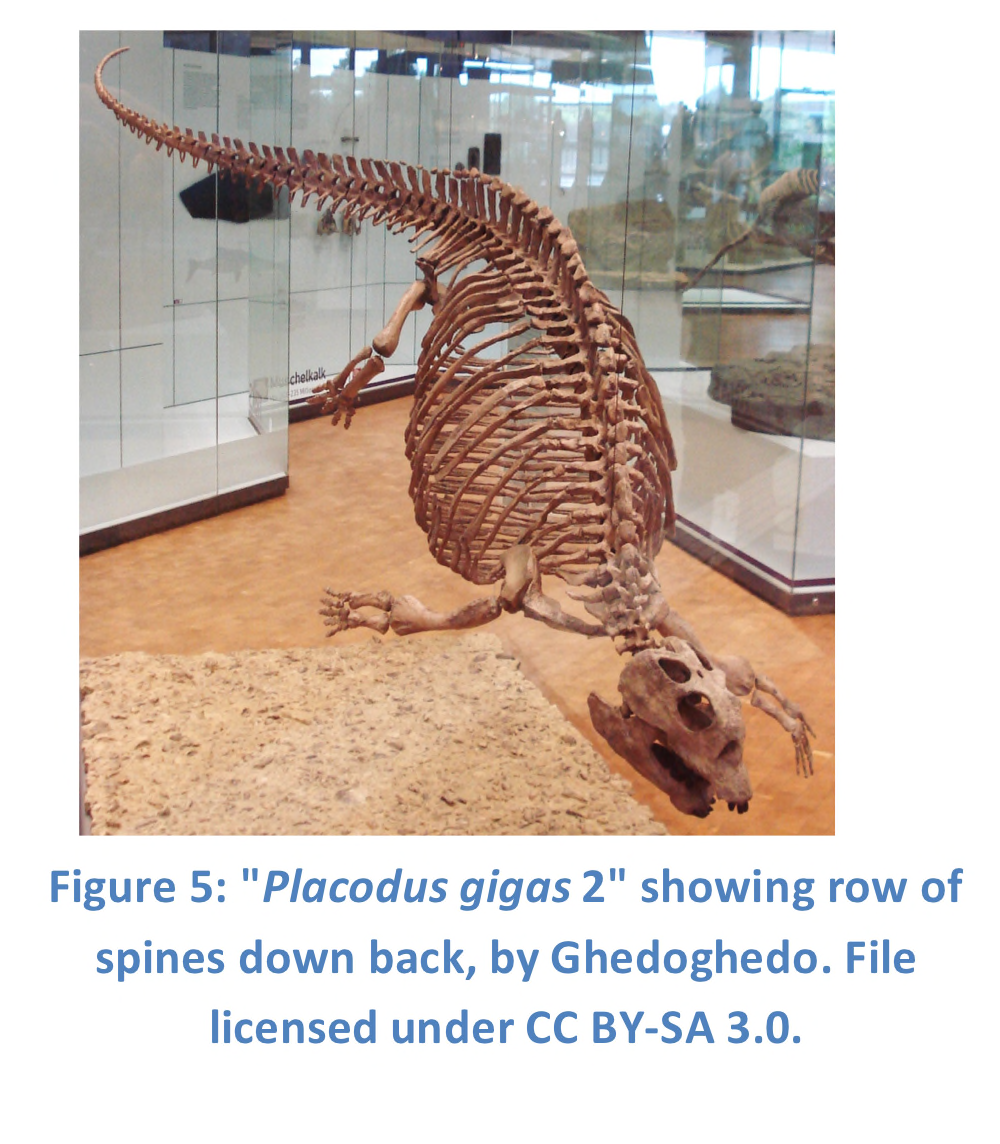
Placodontoids
The clade of placodonts with a barrel-shaped morphology and compressed tails, dense gastrailia to add mass. Includes genera such as Placodus and Paraplacodus.
13
New cards
Placodus and Paraplacodus
Placodontoids, with rows of spines in the middle of the back
14
New cards
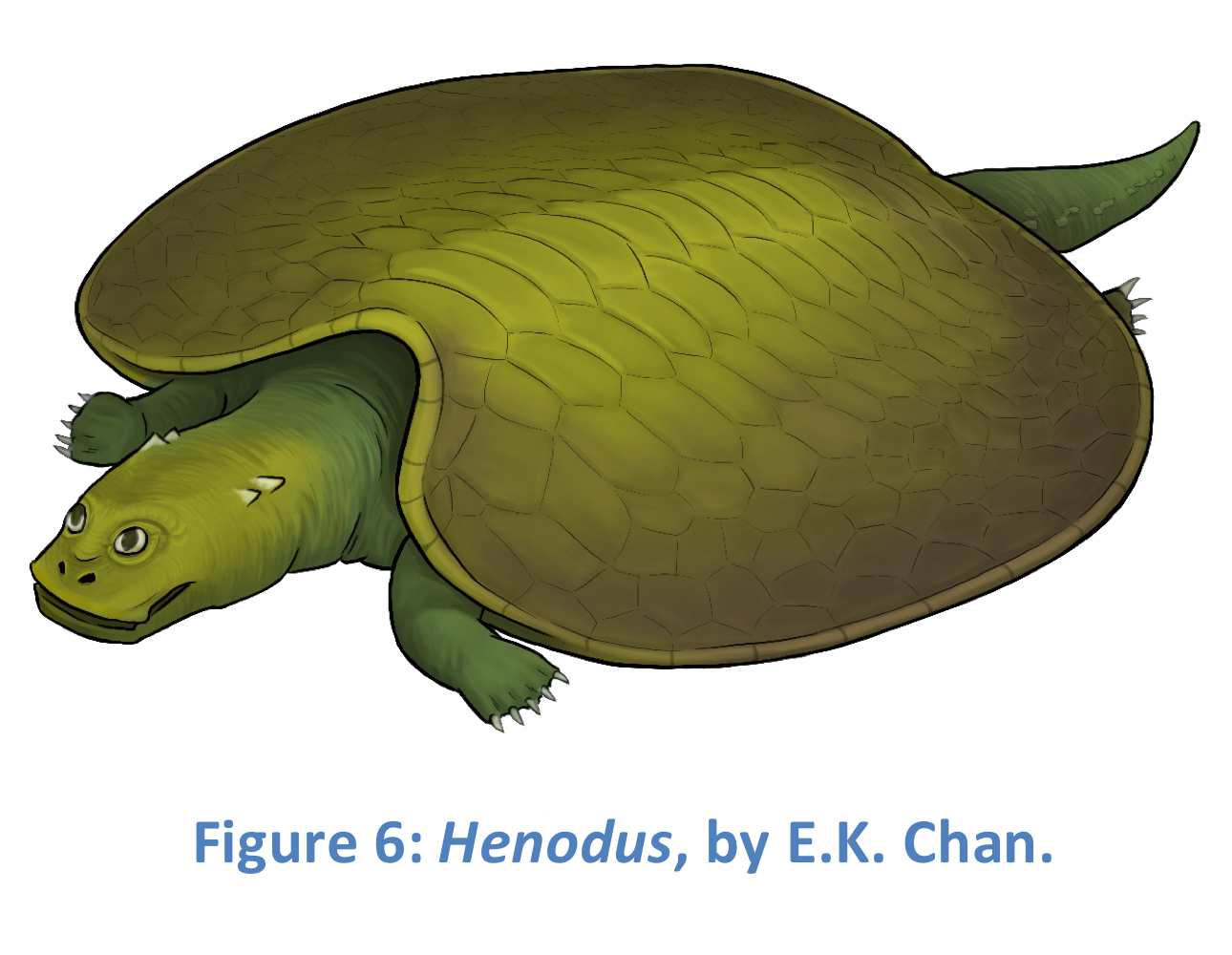
Cyamodontoids
The clade of placodonts with flattened, armored bodies (convergent to turtles). Includes genera such as Henodus, Cyamodus and Placochelys. Carapace covered in keratin, grew from bony tissue deposits in the skin (turtles grew from rib expansion)
15
New cards
Keratin
The structural protein that is the main component of horns, hooves, hair and fingernails.
16
New cards
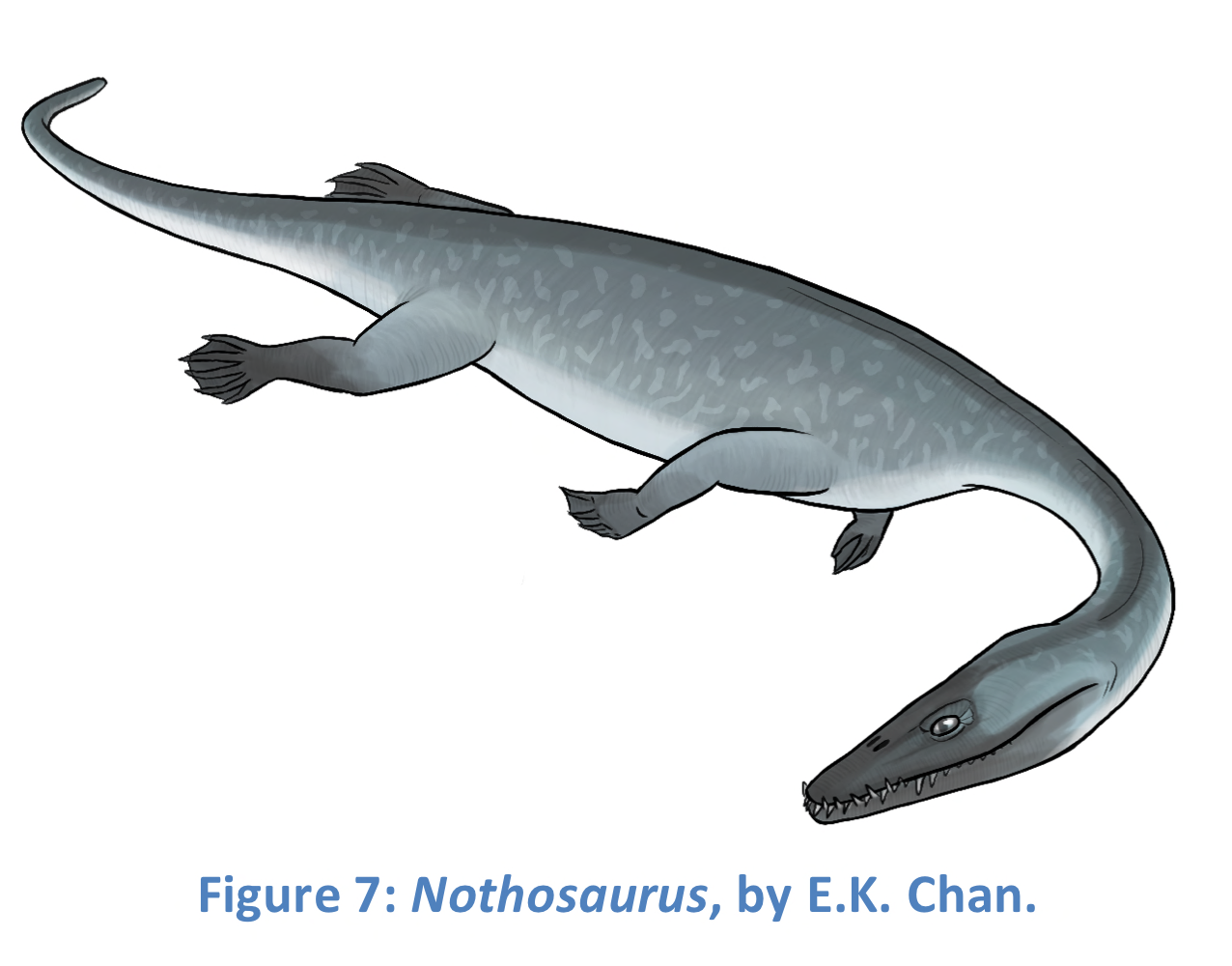
Nothosauroidea (informally, nothosaurs)
A group of basal Triassic sauropterygians with elongate bodies and tails, retracted nares, and webbed feet. Crawled on shore like seals, curved humerus that is not good for supporting weight. Long teeth for squid and small fish. Includes genera such as Lariosaurus and Nothosaurus.

17
New cards
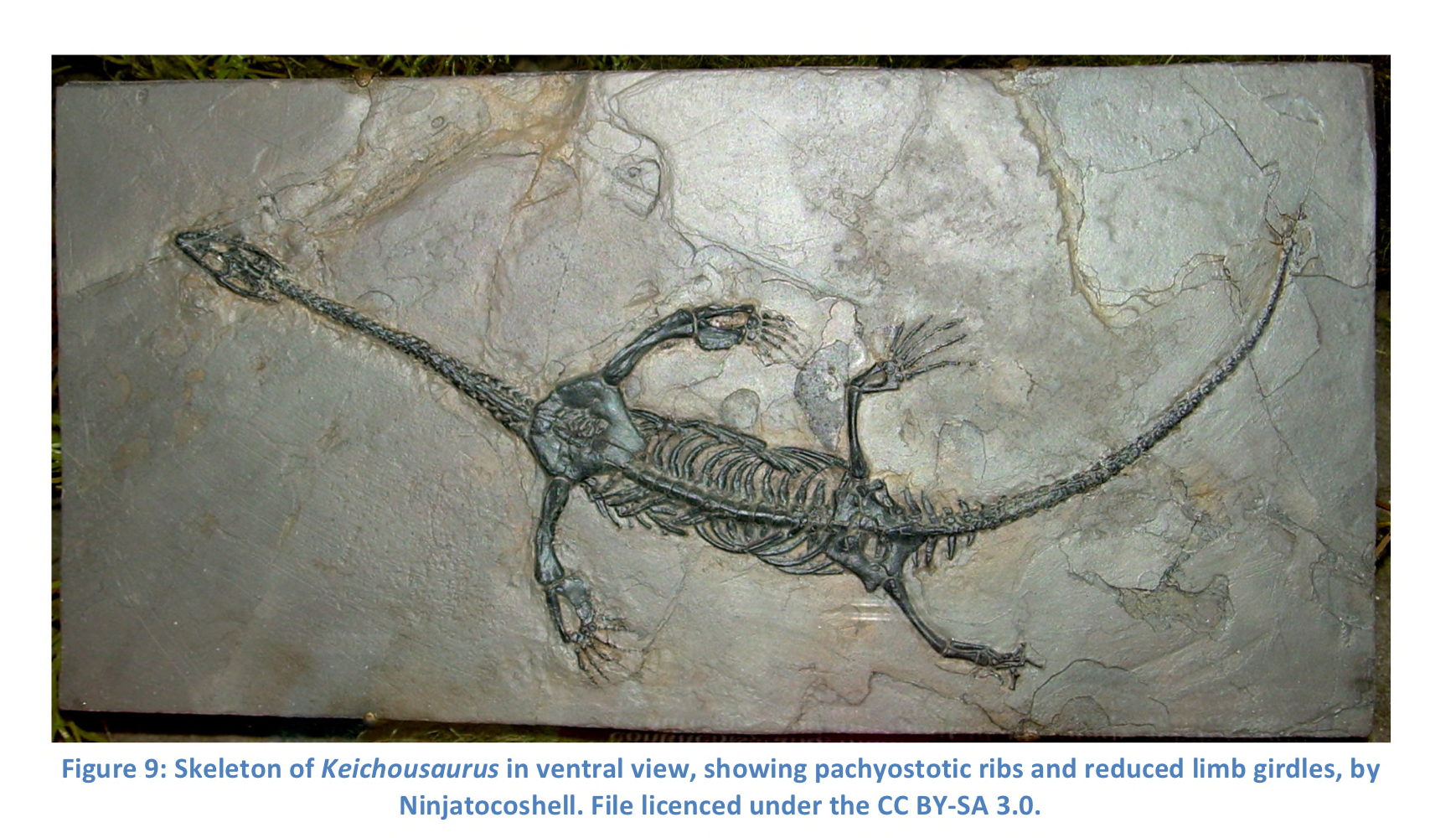
Pachypleurosauria (informally, pachypleurosaurs)
A group of basal Triassic sauropterygians with thickened, pachyostotic ribs and poorly ossified limb girdles. Non efficient paddles, ate small fish and squid in shallow water. Includes genera such as Keichousaurus (spent time on land). Unknown phylogeny - had derived and basil traits
18
New cards
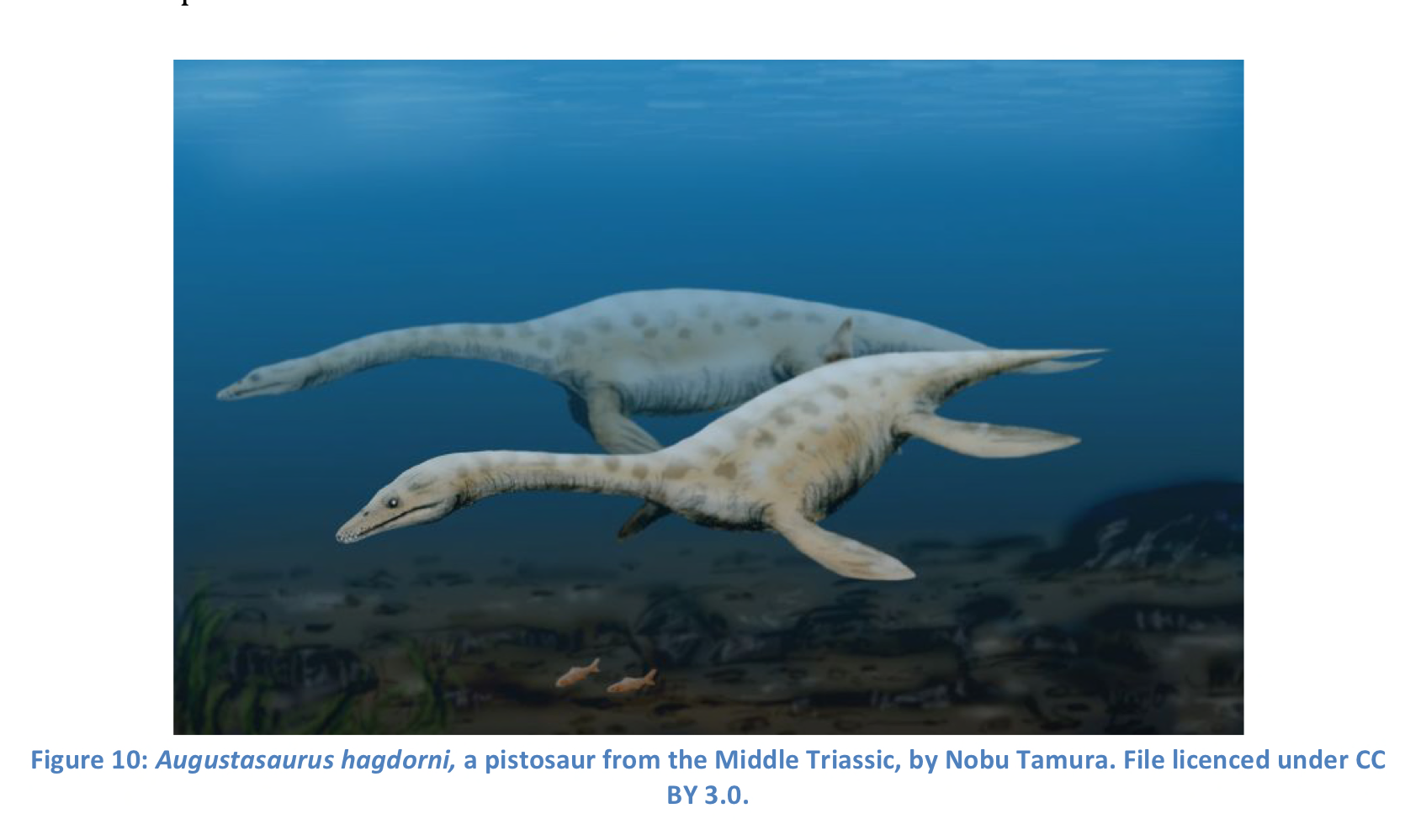
Pistosauroidea (informally, pistosauroids)
Thought to be the sister taxon to the Plesiosauria, poorly known clade. They had a nothosaur-like body and a plesiosaur-like head. Larger limb girdles, hyperphalangy, stronger swimmers
19
New cards
Plesiosauria (informally, plesiosaurs)
1. The group of sauropterygians more derived than the Pistosauroidea. They are characterized by broad, plate-like limb girdles, gastralia and subcentral foramina. Evolved at end of Triassic, only group to survive Triassic sea level fluctuations
2. The outdated clade that contained all of the long necked sauropterygians. It is now understood that this is not a true phylogenetic relationship.
20
New cards
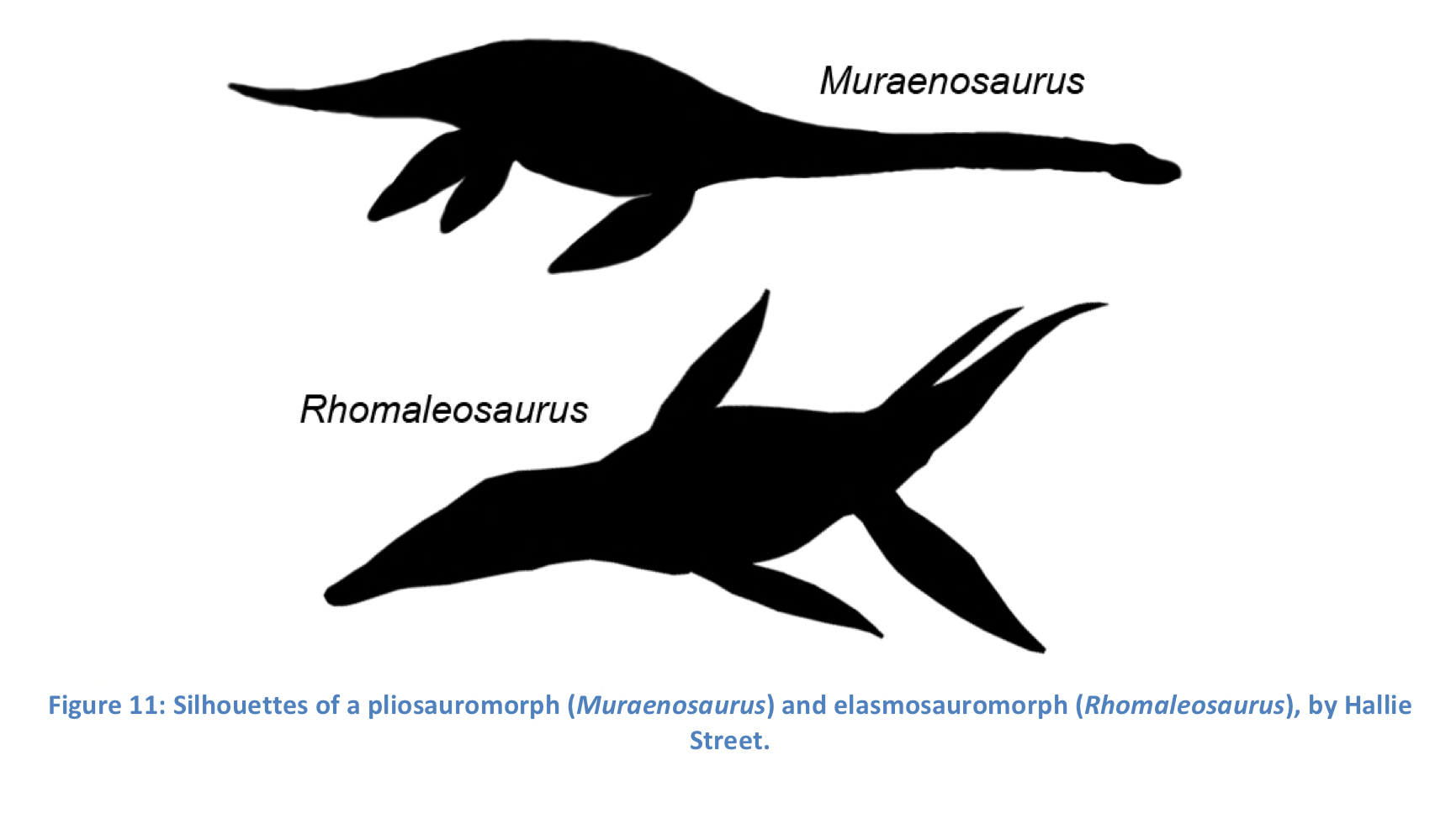
2 Plesiosauria morphotypes
1. Elasmosauromorphs - small head, long neck, delicate pointed teeth
2. Pliosauromorphs - large head, short neck, big teeth
21
New cards
Taxonomy
The system that is used to name and classify organisms.
22
New cards
Valid
A valid species names meets two criteria. First, it must identify a distinct species with diagnosable differences that distinguish it from all other species. And second, the combination of genus and species names must be unique to that species.
23
New cards
Pliosauria (informally, pliosaurs)
The outdated clade that contained all of the large headed sauropterygians. It is now understood that this is not a true phylogenetic relationship.
24
New cards
Morphotype
A grouping based on morphological similarity rather than phylogenetic relationships. Useful for talking about convergent lifestyles in similar looking animals.
25
New cards
Pistosauria (informally, pistosaurs)
The clade comprised of the Pistosauroidea and the Plesiosauria.
26
New cards
Diagnostic character
A physical feature which all members of a given phylogenetic group have, which differentiates them from species not in that group.
27
New cards
Subcentral foramina
A pair of holes in the ventral surface of plesiosaur cervical vertebrae that allowed the passage of nerves. A diagnostic character of the Plesiosauria.
28
New cards
Archaeonectrus rostratus
A primitive Triassic plesiosaur that does not belong to the Pliosauroidea or the Plesiosauroidea. Shows some hyperphalangy.
29
New cards
Attenborosaurus conybeari
A primitive Triassic plesiosaur that does not belong to the Pliosauroidea or the Plesiosauroidea. The genus is named after David Attenborough, the species after William Conybeare.
30
New cards

Diagnostic Plesiosauria Charcteristics
1. Scapula verticals to clavicle
2. Pectoral/pelvic griddle were broad plates in abdominal wall, support long narrow flippers
3. Gastrailia not attached to spinal column
4. Subcentral foramina
31
New cards
Pliosauroidea (informally, pliosauroids)
One of two major lineages within the Plesiosauria. Contains the Pliosauridae and the Rhomaleosauridae. Members typically showed the pliosauromorph body plan and were characterized by a lower jaw connected by a short joint.
32
New cards

Pliosauridae (informally, pliosaurids)
A Jurassic to Late Cretaceous sauropterygian family within the Pliosauroidea. They had massive heads and short necks with short snouts. Included genera such as Liopleurodon, Pliosaurus, Kronosaurus, Peloneustes, and Brachauchenius. 2 halves of lower jaw connected by a short joint between few massive front teeth
33
New cards

Rhomaleosauridae (informally, rhomaleosaurids)
An Early to Mid-Jurassic sauropterygian family within the Pliosauridae. Had large flippers, fairly long necks, short snouts and a long tail. Large limb girdles with long flippers. Includes genera such as Borealonectes.
34
New cards
Liopleurodon
Pliosauridae, one of the largest plesiosauromorph in the Jurassic , small teeth with sharp cutting edges to hunt large fish and marine reptiles
35
New cards

Kronosaurus
Pliosauridae, one of the largest plesiosauromorphs, very large smooth teeth without cutting edges, named after Kronos, only swallowed prey whole
36
New cards
Plesiosauroidea (informally, plesiosauroids)
One of two major lineages within the Plesiosauria. Contains the Cryptoclidia, Elasmosauridae and Plesiosauridae. Characterized by a lack of nasal bones.
37
New cards
Plesiosauridae (informally, plesiosaurids)
A sauropterygian family within the Plesiosauroidea. Typified by the first described plesiosaur: Plesiosaurus. Wastebasket taxon, first discovered by Mary Anning
38
New cards
Wastebasket taxon
A clade that contains many unrelated specimens that have been grouped together because they look vaguely similar and/or because researchers did not know where else to assign them.
39
New cards
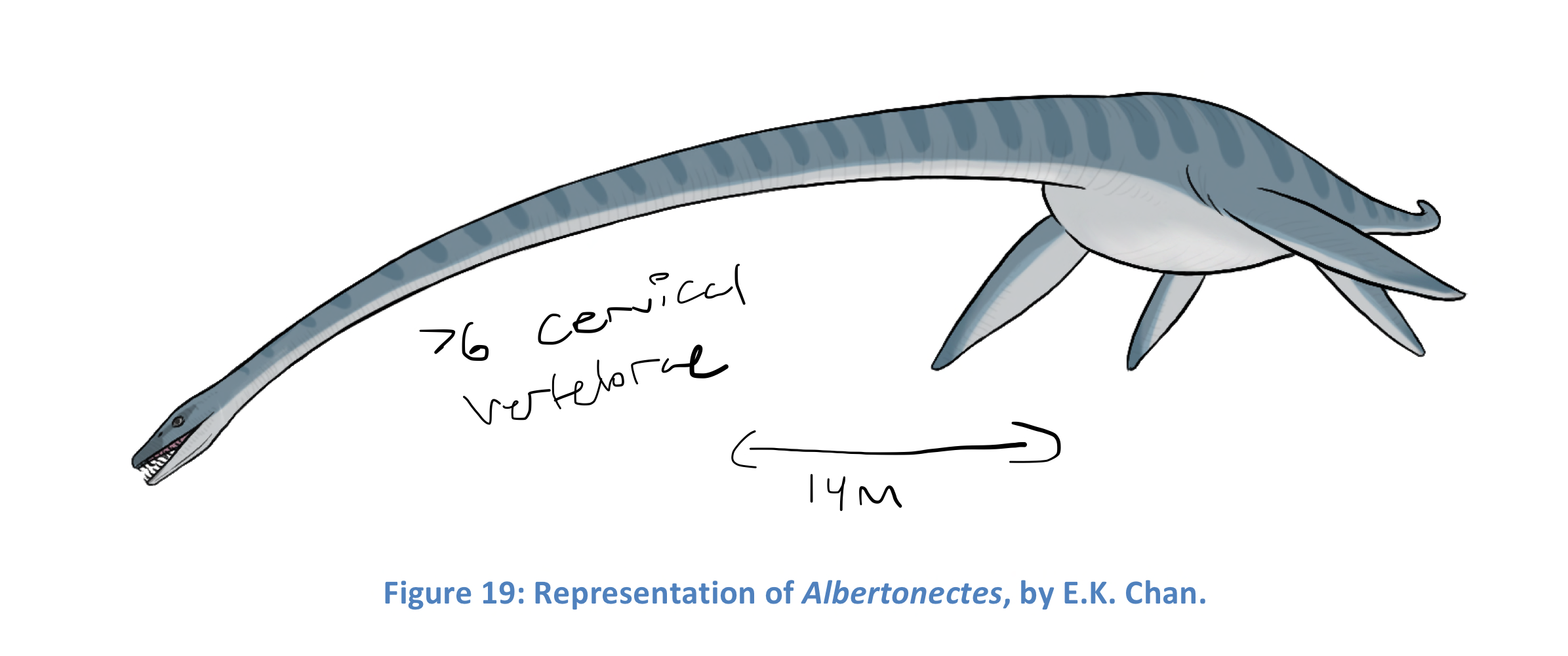
Elasmosauridae (informally, elasmosaurids)
A sauropterygian family within the Plesiosauroidea. Characterized by long necks that have at least 40 cervical vertebrae and tiny heads that evolved convergently. Diversified in Cretaceous oceans. Needle like teeth for small fish and squid. Bay shaped indentation in pectoral girdles. Include genera such as Elasmosaurus, Albertonectes, Terminonatator and Cimoliasaurus.
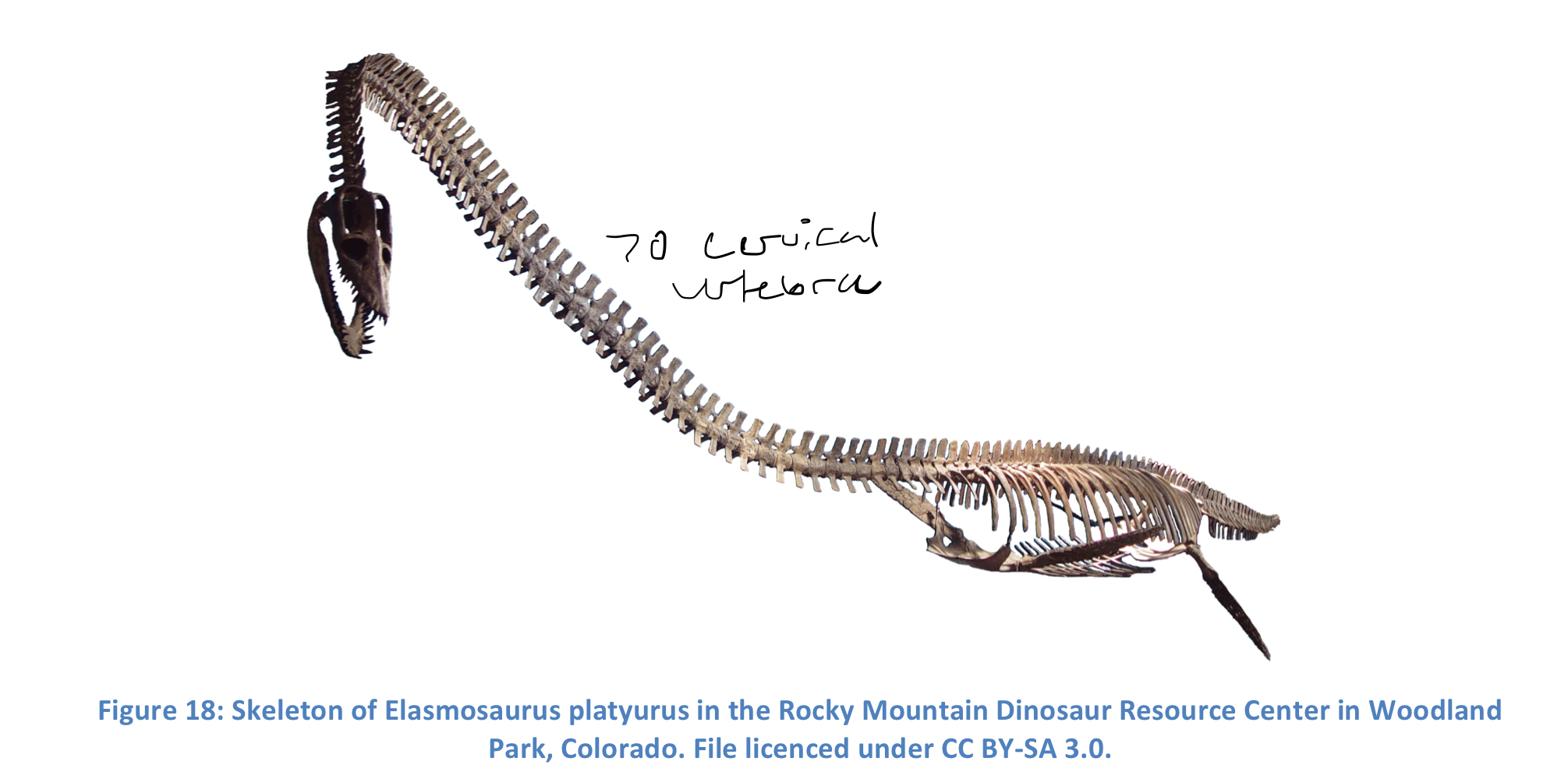
40
New cards
Cryptoclidia (informally, cryptoclids)
A clade of sauropterygians within the Plesiosauroidea characterized by a small clavicle hidden in a depression on the inner surface of the shoulder girdle, arrangement of bones in roof of mouth. Evolved in Jurassic, includes all body types. This clade contains the Cryptoclididae, Leptoclididae and Polycotylidae.
41
New cards
Type genus
The genus that a family is named after. Usually, it is the first, and most important, genus in the family.
42
New cards
Type species
The species that a family is named for. Usually it is the first species discovered and described within that family.
43
New cards
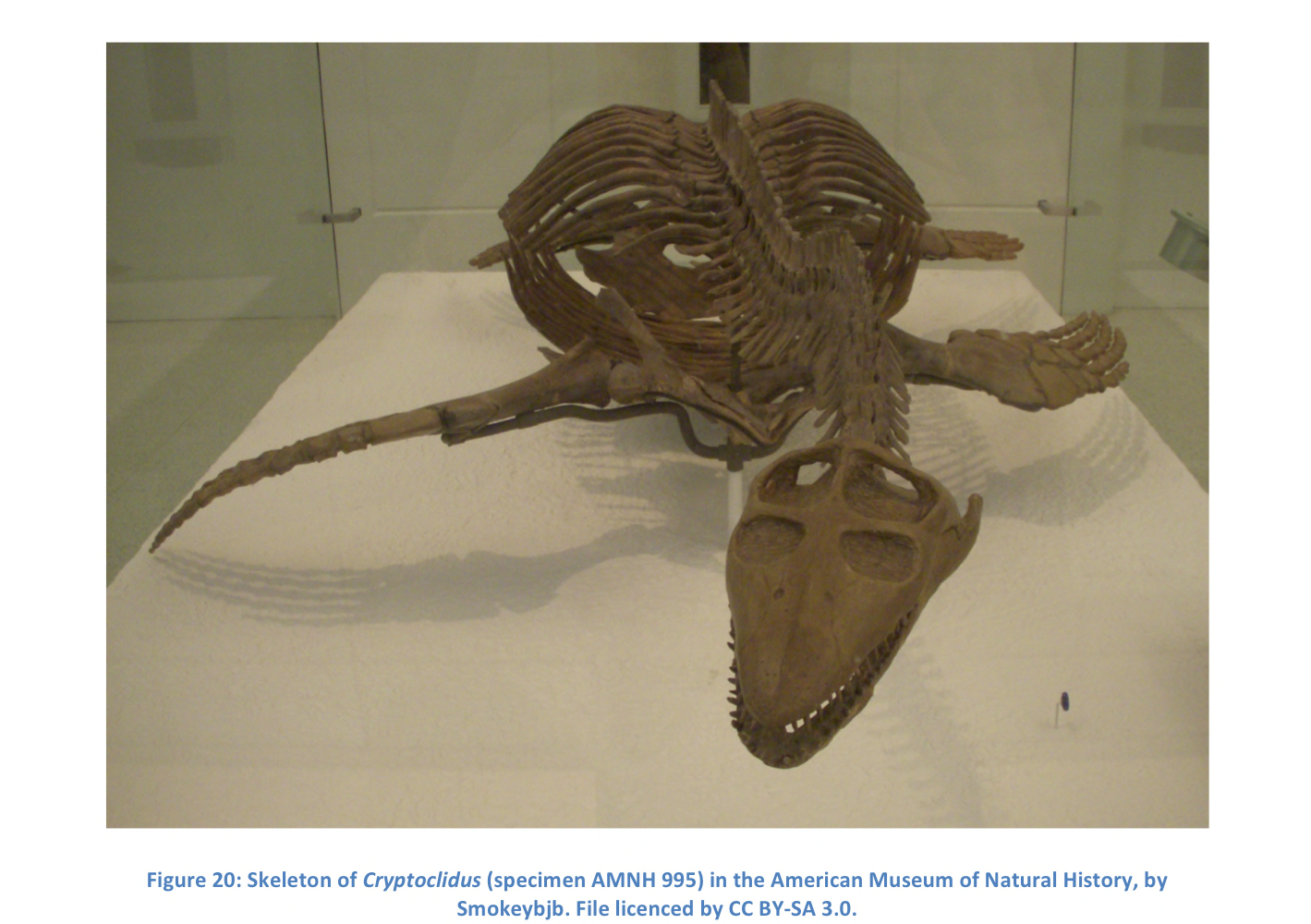
Cryptoclididae (informally, cryptoclidids)
A Jurassic sauropterygian family within the Cryptoclidia. Small head and long neck. Triangular arrangement of bones in the mouth. Includes the genera Muraenosaurus, Tatenectes and Cryptoclidus, which is one of the most common plesiosaur fossils in the world.
44
New cards
Leptocleididae (informally, leptocleidids)
A Cretaceous sauropterygian family within the Cryptoclidia. They have fairly large heads, short necks, and a crest on the skull. Narrow teeth, jaws not expanded in front, longer joint between 2 hales of the jaw, small. Includes the genera Umoonasaurus and Nichollsauria.
45
New cards
Polycotylidae (informally, polycotylids)
A Cretaceous sauropterygian family within the Cryptoclidia. They have fairly large heads, short necks, and a crest on the skull. Narrow teeth, jaws not expanded in front, longer joint between 2 hales of the jaw, small. Includes the genus Polycotylus and Trinacromerum.
46
New cards
Modern analogue
An extant animal with a similar morphology to an extinct animal, which is assumed to have similar physiology and/or behaviours. Used to determine plesiosaur locomotion
47
New cards
Plesiosaur locomotion
Appendicular - unique 4 large flippers to generate thrust, not axial because: short stubby tails, rigid body due to ribs and gastrailia, no
48
New cards
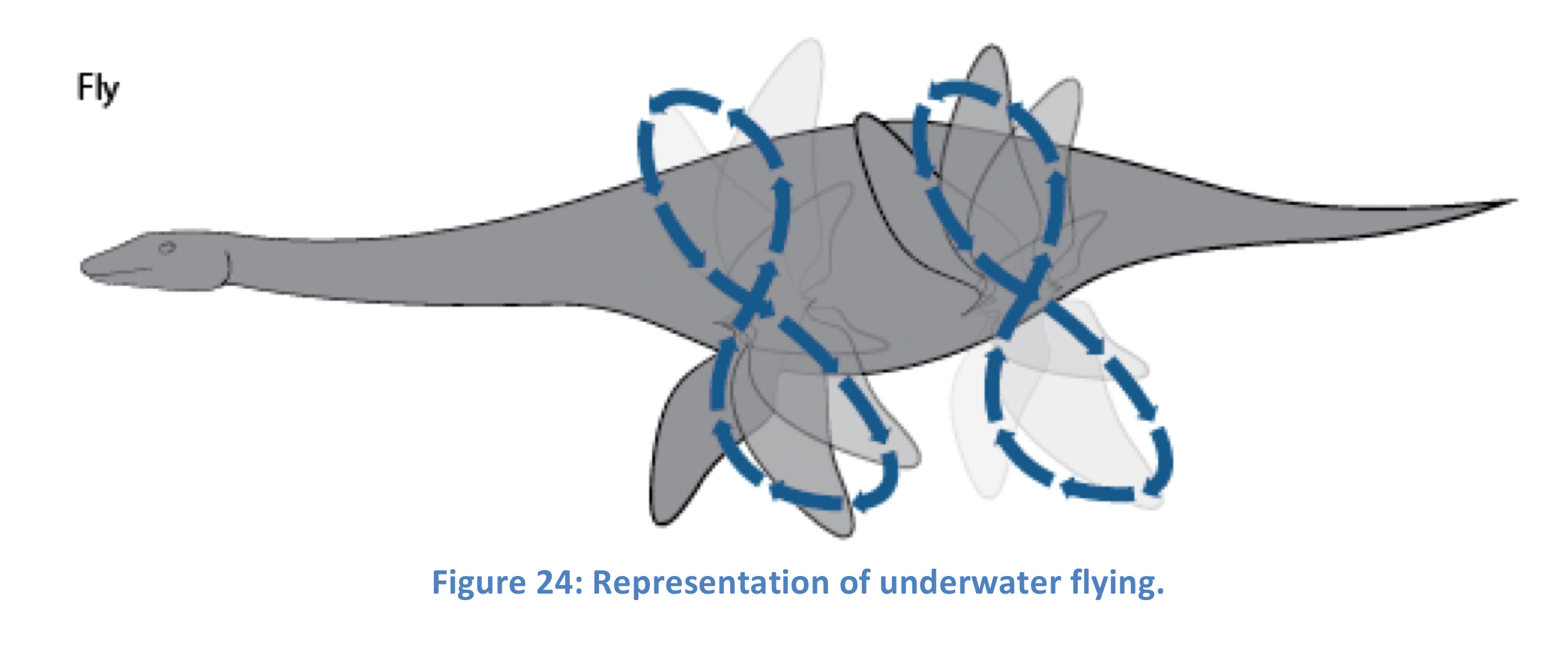
Underwater flying
A locomotion style seen in some appendicular swimmers such as sea turtles. It is the same figure-eight motion seen in a bird's wing as it flies. This style generates lift continuously through the motion. Modified version in plesiosaurs because of restricted upward shoulder movement
49
New cards

Rowing
A locomotion style seen in some appendicular swimmers such as seals. The broad edge of the limb pulls backward horizontally to generate thrust, and the narrow edge moves forward in the recovery stroke. Not seen in plesiosaurs because flippers could not move upward and behind back
50
New cards

Paddling
A locomotion style seen in some appendicular swimmers such as ducks. The limbs are pulled broad-side through the water in a vertical plane to generate thrust.
51
New cards
Aspect ratio
The length divided by the width. A measurement that influences energy efficiency and manoeuvrability in a wing or flipper.
52
New cards

Elasmosaur Flippers
Long and thin with a high aspect ratio, good for long distance cruising, ambush prey after swimming long distances. Increased lift, increased drag because of large surface area
53
New cards
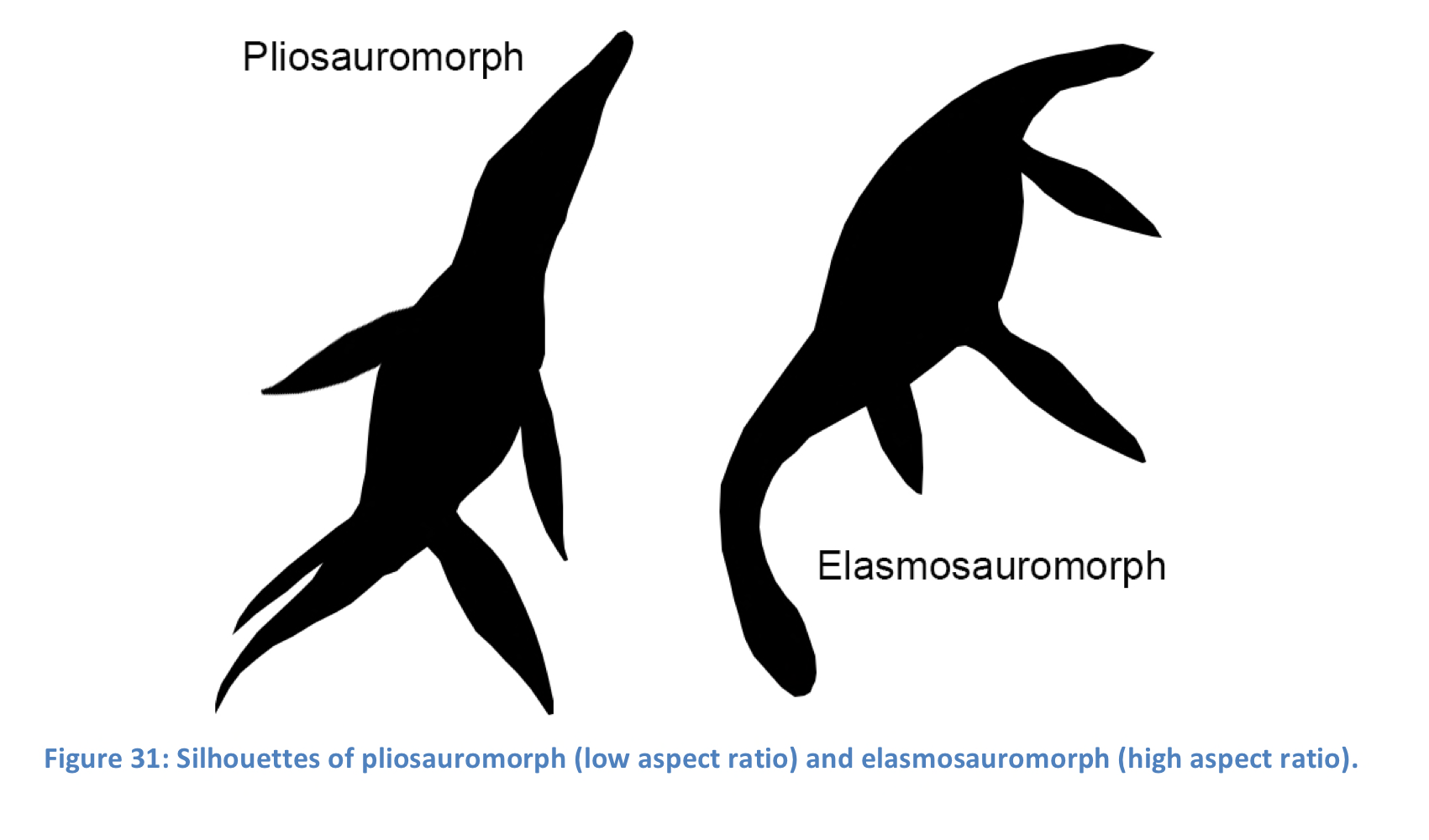
Pliosaur Flippers
Big, broad and short flippers, low aspect ratio, fast manoeuvring, chased prey, turned quickly, decreased drag, more energy needed to stay afloat because of decreased lift, evolved convergently
54
New cards

Hydrofoil
A cross-sectional shape of a flattened oval, where the base is flat and the upper surface is curved. Seen in wings and flippers that generate lift in the water. The same shape in air is called an airfoil.
55
New cards
Lift
The force that pulls an object up.
56
New cards
Angle of attack
The direction in which an airfoil or hydrofoil points in order to change the direction in which the force of lift is generated.
57
New cards
Plesiosaur Body
Smooth skin, streamlined, almond shape (5 and 1/2 times long as it is wide) rigid bodies (stiff bc shoulders, ribs, gastrailia, appendicular flying swimmers, muscles pull limbs down and back, with limited forward movement.
58
New cards
Plesiosaur Flippers
Less degree of hyperphalangy (16) phalanges fixed with strong connective tissue and cartilage, elbows, wrists flippers were all stiff
59
New cards
Elasmosaurus Necks
Necks cause a lot of inertial drag, bad for speed and steering, thick rigid muscles at the bottom of the neck to correct steering issues, upward curve increases lift and help breathe, to heavy to lift above water, dorsally positioned nostrils
60
New cards
Hydrodynamic Head Position
Neck held out in front instead of upright, increase drag because of increased surface area, but the body has less drag because of this, needs smooth, consistent swimming motion like flying, acceleration and deceleration causes stiff neck to jerk around
61
New cards
Modified Flight Clues
1. Downward and backward motion of muscles
2. Range of motion in shoulder and arm sockets (best supports underwater flying but recovery stroke restricted, rowing prohibited)
3. Rigid body -rigid thorax and gastailia
4. Hydrofoil cross-section of a flipper
5. Long neck - benefits from underwater flying
62
New cards

Modified Flight
Done and power structure provide lift and thrust for flying, horizontal recovery like rowing, moved in synchronization, front limbs provide thrust, back limbs provide steering, glided between strokes with front flippers
63
New cards
Adaptations for Hunting Underwater
Bony rings in eyes to support eye pressure and adjust aperture, no eardrum, detects vibrations from inner ear to skulls, scoop shaped openings in roof of mouth to direct water into sense receptors, water flows out of nostrils (Like sharks)
64
New cards
Sauropterygian Reproduction
Originally thought to be oviparous, not true because necks to heavy and flippers could not drag body across land, Actually viviparous. Keichosaurus - pachypleurosaur found with embryo in body
Polycotylus- derived plesiosaur found with 1.5m long embryo inside body
Parental care for one big baby at a time, maybe lived in groups of extended families, lost of baby plesiosaurs found in Australia - probably a breeding ground
Polycotylus- derived plesiosaur found with 1.5m long embryo inside body
Parental care for one big baby at a time, maybe lived in groups of extended families, lost of baby plesiosaurs found in Australia - probably a breeding ground
65
New cards
Sauropterygian Evolution
Longest lived in all 3 lineages of marine reptiles, originated and diversified in early Triassic, near-shore form extinct by end of Triassic, fully aquatic dominated Jurassic, reduced in Cretaceous seaways
66
New cards
Endemism
When a species is only found in one place, such as a nation, an island, a cave or a body of water.
67
New cards
Sauropterygian Early Triassic
Lived in shallow Tethys sea, evolution tied to rising sea levels, continental flooding during Triassic, marine basins favour endemism, unspecialized forms similar to pachypleurosaurs, got cut off when ocean basins became isolated due to sea level fluctuations, lead to diversity
68
New cards
Sauropterygian Early Triassic

69
New cards
Sauropterygian Middle Triassic
Collection bias compared to early Jurassic, placodonts, nothosaurs, pachypleurosaurs and pistosaurs inhabited same shallow seaways, all had similar morphologies except for placodonts, semi-aquatic with long distance swimming, survived through niche portioning
70
New cards
Sauropterygian Middle Triassic
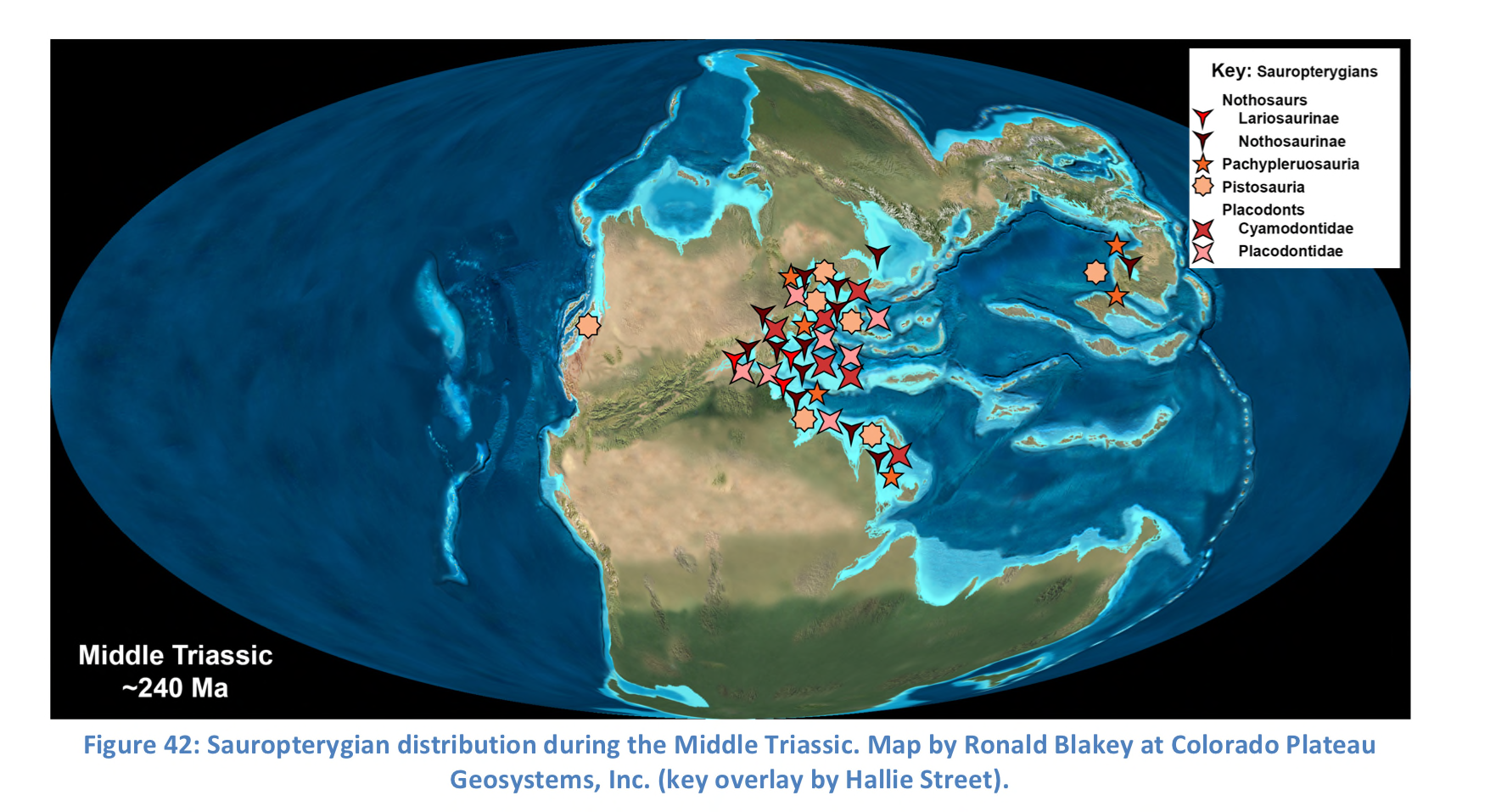
71
New cards
Sauropterygian Late Triassic
Plesiosaurs evolved from pistosaur ancestors and lived in open oceans, fossils from southern England and Ghizou in China (thought they were dragons) shared seas with basal Sauropterygians till extinction events, shallow sea environments lost
72
New cards
Sauropterygian Late Triassic
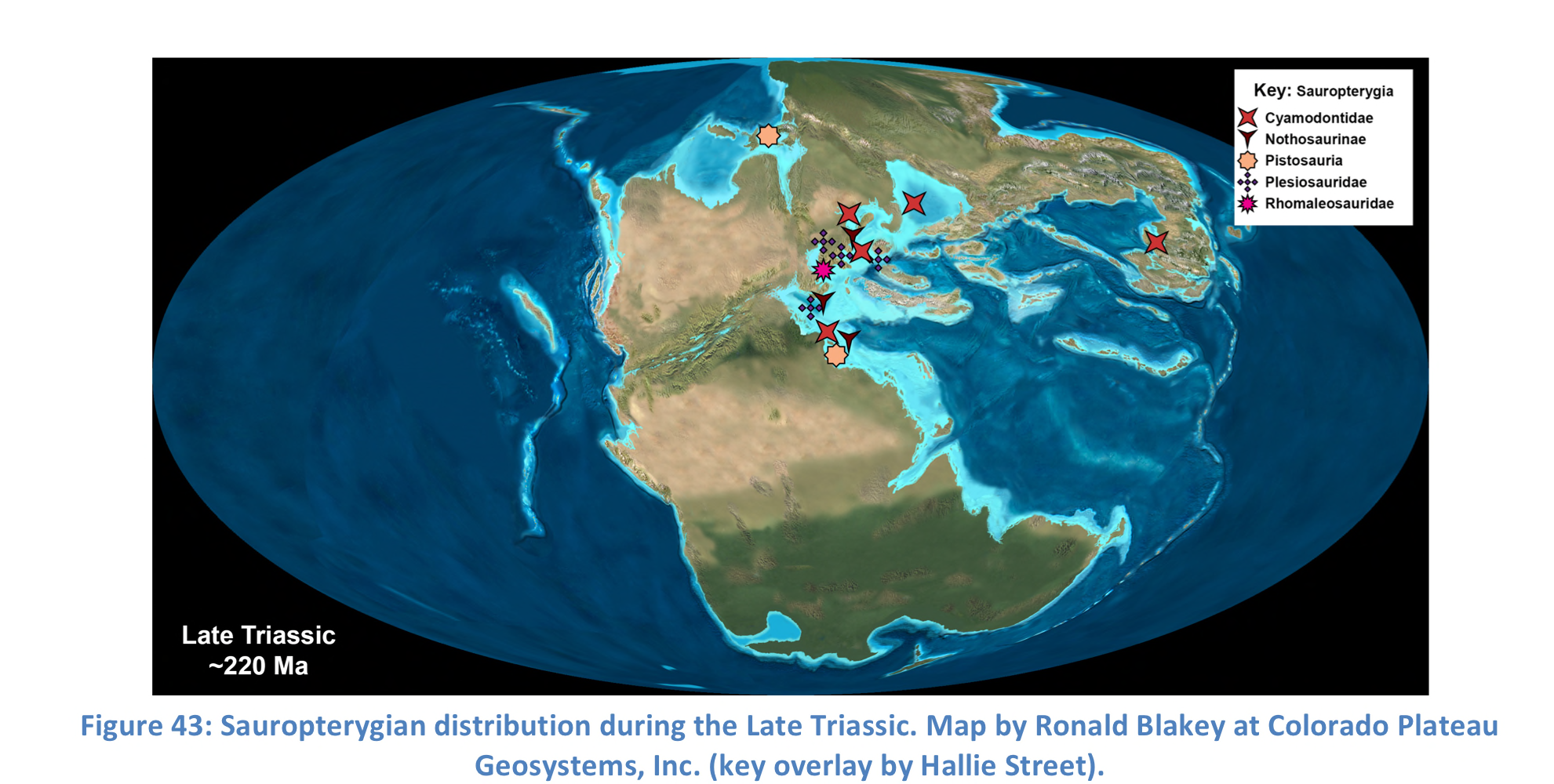
73
New cards
Niche partitioning
When species use different spaces or resources within their ecosystems in order to avoid competition with each other.
74
New cards
Collection bias
When data (such as fossils) are collected in such a way that some are less likely to be collected than others.
75
New cards
Sauropterygian Early Jurassic
Plesiosaurs diversified, had unspecialized ancestors that looked like Attenborosaurus and Archaeonectus, Rhomaleosaurids first group to become widespread worldwide, Mary Anning found first plesiosaur fossils
76
New cards
Sauropterygian Early Jurassic

77
New cards
Sauropterygian Middle Jurassic
Pliosauridae replaces Rhomaleosaurids as top predators, cryptocleidia diversified (cryptoclidus and peloneustes found in oxford and Kimmerdige clays in UK in middle/upper Jurassic strata),found with dinos, thalattosuchians and plesiosaurs. Borealnectes russelli Rhomaleosaurids found in artic of Northwest Territories (best preserved skull)
78
New cards
Sauropterygian Middle Jurassic
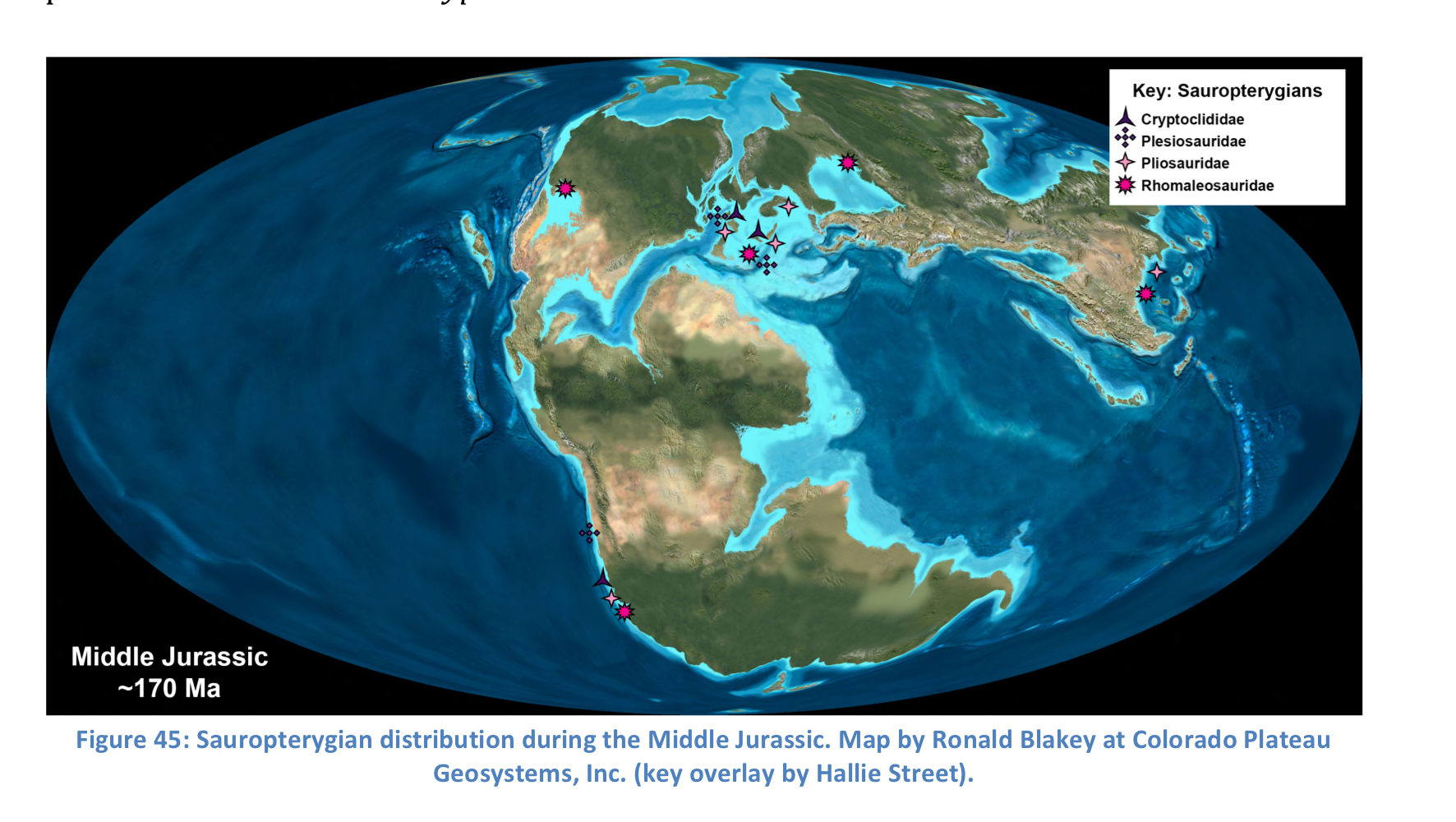
79
New cards
Sauropterygian Late Jurassic
Global sea level rises, Sundance sea formed, Cryptoclidid Tatenectus laramiensis was well adapted to shallow water with a wide and flat body like a turtle. Cryptoclidids went extinct during marine Tithonus extinction at end of Jurassic, some pliosauria survived into the Cretaceous
80
New cards
Sauropterygian Late Jurassic

81
New cards
Sauropterygian Early Cretaceous
Marine deposits poorly known, leptocleidids plesiosaurs from Germany and UK, probably collection bias
82
New cards
Sauropterygian Early Cretaceous
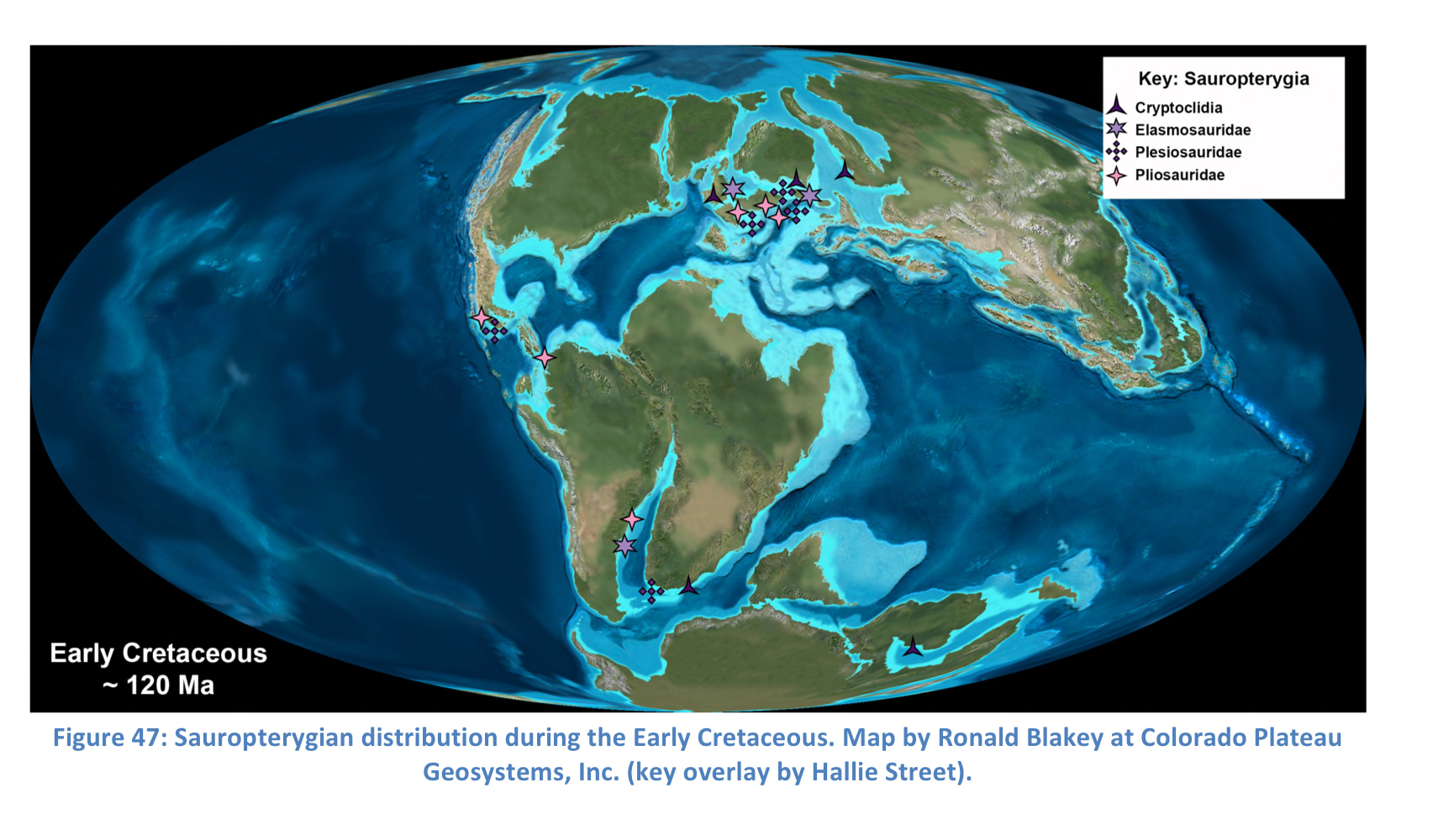
83
New cards
Sauropterygian Mid Cretaceous
Elasmosaurids developed and diversified, evolved in southern hemisphere (Columbia and Australia), cryptocleidia survived until after half of the Cretaceous, leptocleidid Nichollsaura borealis replaces by polycotylids
84
New cards
Sauropterygian Mid Cretaceous

85
New cards
Sundance Sea
A waterway that bisected North America in the mid-Jurassic.
86
New cards
Western Interior Seaway
A transcontinental ocean that separated North America into two continents during the mid-late Cretaceous. It stretched from the Gulf of Mexico to the Arctic Ocean.
87
New cards
Trans-Saharan Seaway
An epicontinental waterway that bisected Northern Africa in the Late Cretaceous.
88
New cards
Aristonectidae
A possible family of elasmosauromorphs from the Southern Pacific.
89
New cards
Sauropterygian Late Cretaceous
Decreased diversity, ploycotylidae and elasmosauridea survived until end-Cretaceous, Brachauctenius - 1 of 2 last pliosaur mega predator and went extinct when mosasaurs appeared, western interiors sea formed, Trinacromerum polycotylids had longest flippers ever (equal to length of vertebral column, elasmosaurs widespread with fossils on every continent
90
New cards
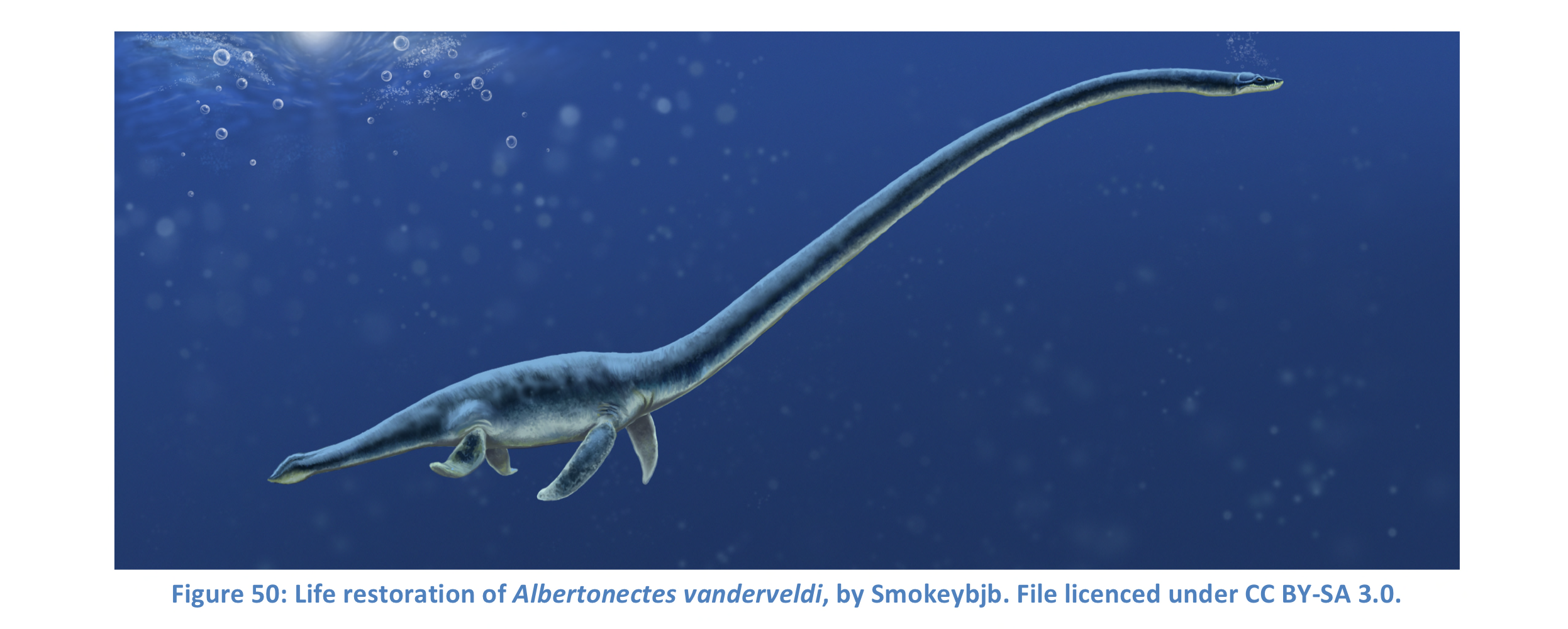
Important Elasmosaurids during Late Cretaceous
Clade Aristonectidaw found in South America, New Zealand and Antarctica. Terminonator ponteixensis found in Saskatchewan as an immature adult, Albertonectes vanderweldi found in Alberta had the most cervical vertebrae. Cimoliosaurus was the longest plesiosaur fossil in the Northwest territory
91
New cards
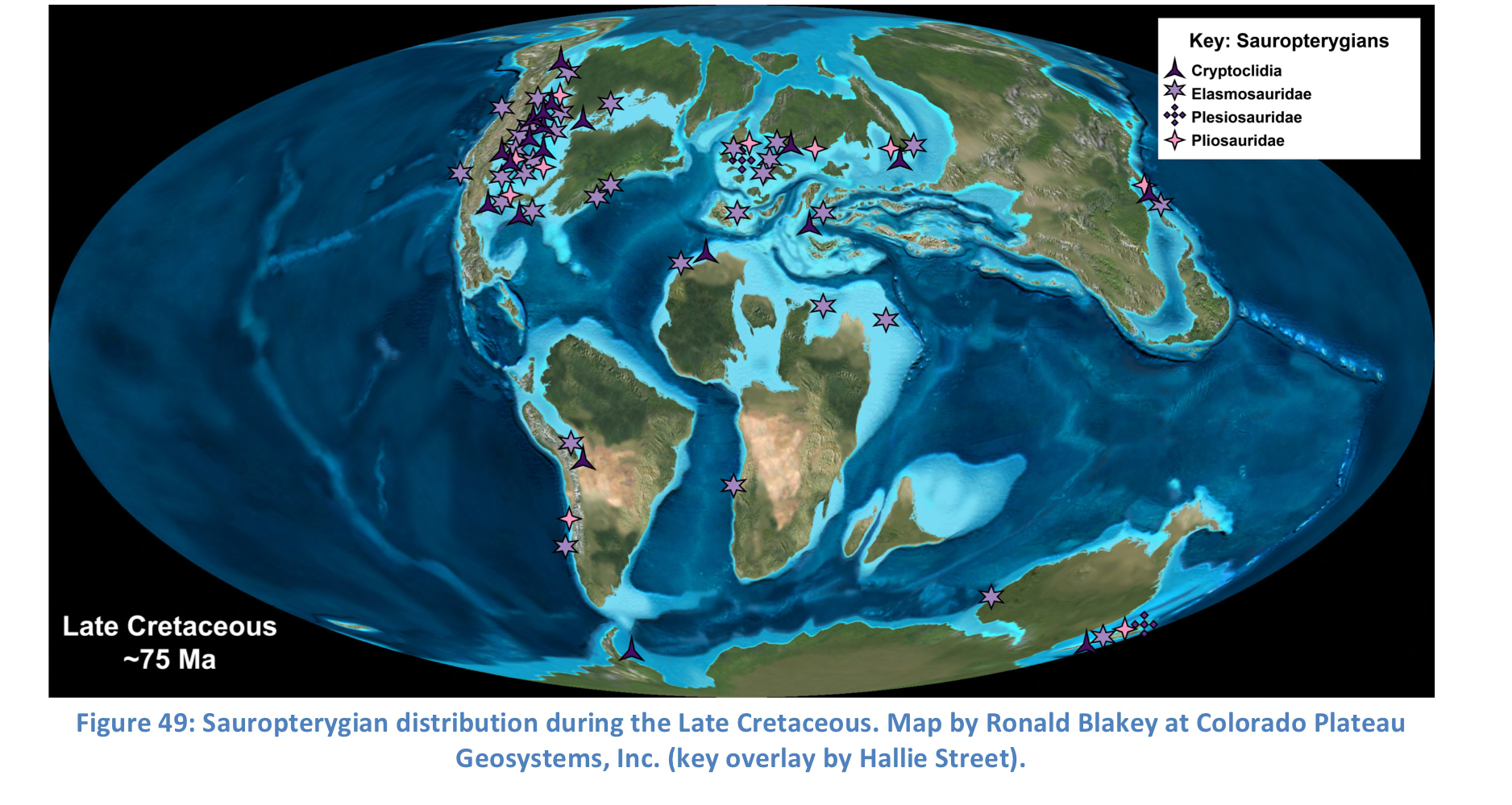
Sauropterygian Late Cretaceous
92
New cards
Mosasauroids
A group of aquatic lepidosaurs from the Late Cretaceous. Best known for the most derived members, the mosasaurs.
93
New cards

Mosasaur Skull
Diapsid, lost bone that forms lower temporal fenestrae, open space remained, Kenetic skull like snakes
94
New cards
Mosasaur Lineage Hypotheses
1. Part of Varanoid lizards (monitor lizards like Komodo dragon)
2. Part of anguimorph lizards
3. Part of pythonomorpha (probably sister group to snakes)
Part of lepidosauromorphs and squmates
95
New cards
Baron Georges Cuvier
Known as the father of comparative anatomy and palaeontology.
96
New cards
Squamata (informally, squamates)
The group of lepidosaurs that includes all modern lizards and snakes.
97
New cards
Anguimorpha (informally, anguimorphs)
The group of lepidosaurs that includes extant animals such as alligator lizards, glass lizards and legless lizards.
98
New cards
6 ages of the Cretaceous
Cenomanian, Turonian, Conician, Santonian, Campanian (longest age), Maastrichtian
99
New cards
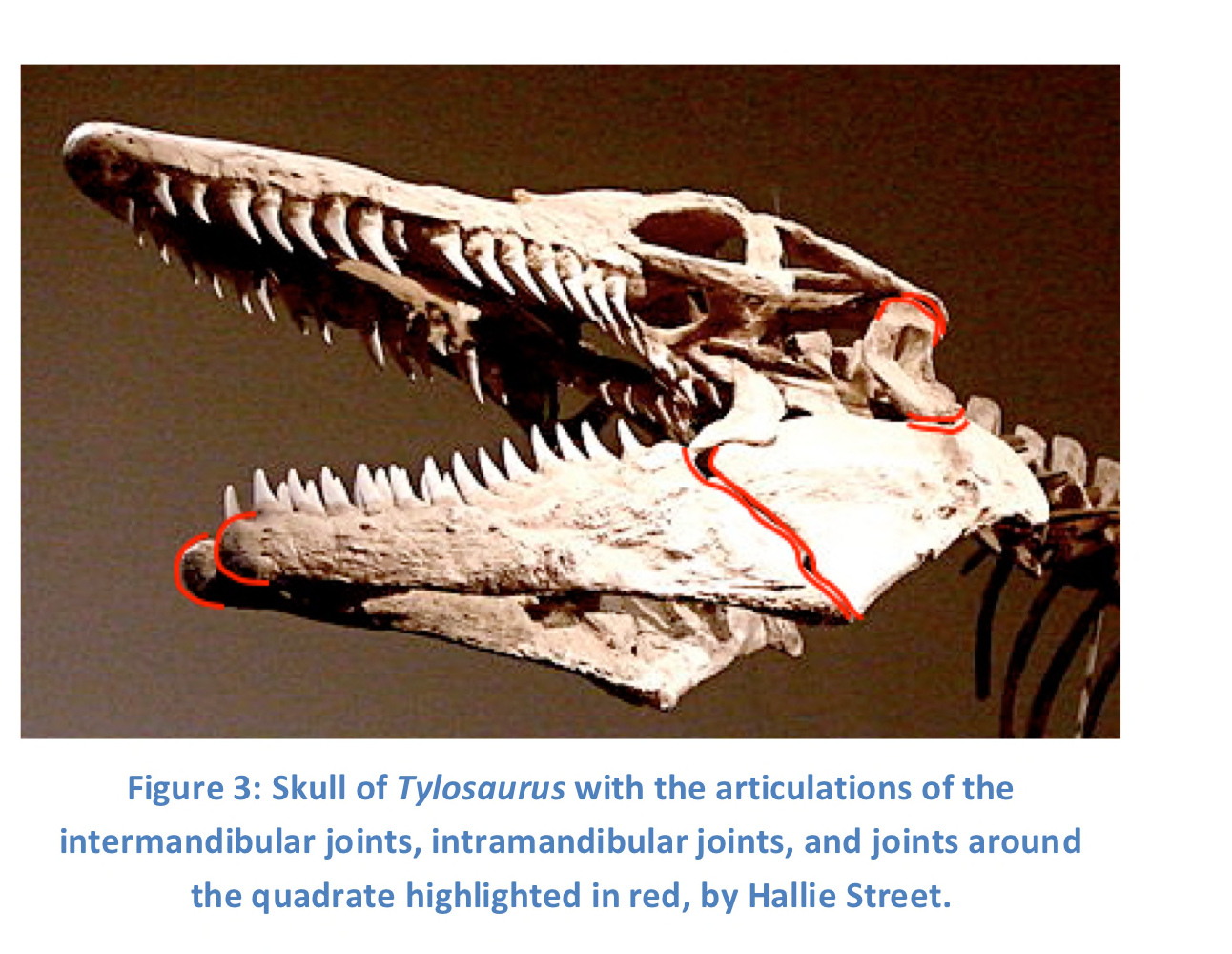
Intramandibular joint
A joint in the middle of each lower jaw of mosasauroids and snakes that helps expand the gape of the animal during feeding. Joint between 2 halves of jaws suppoted by back half of the teeth, allows lower jaw to bend in the middle to expand
100
New cards
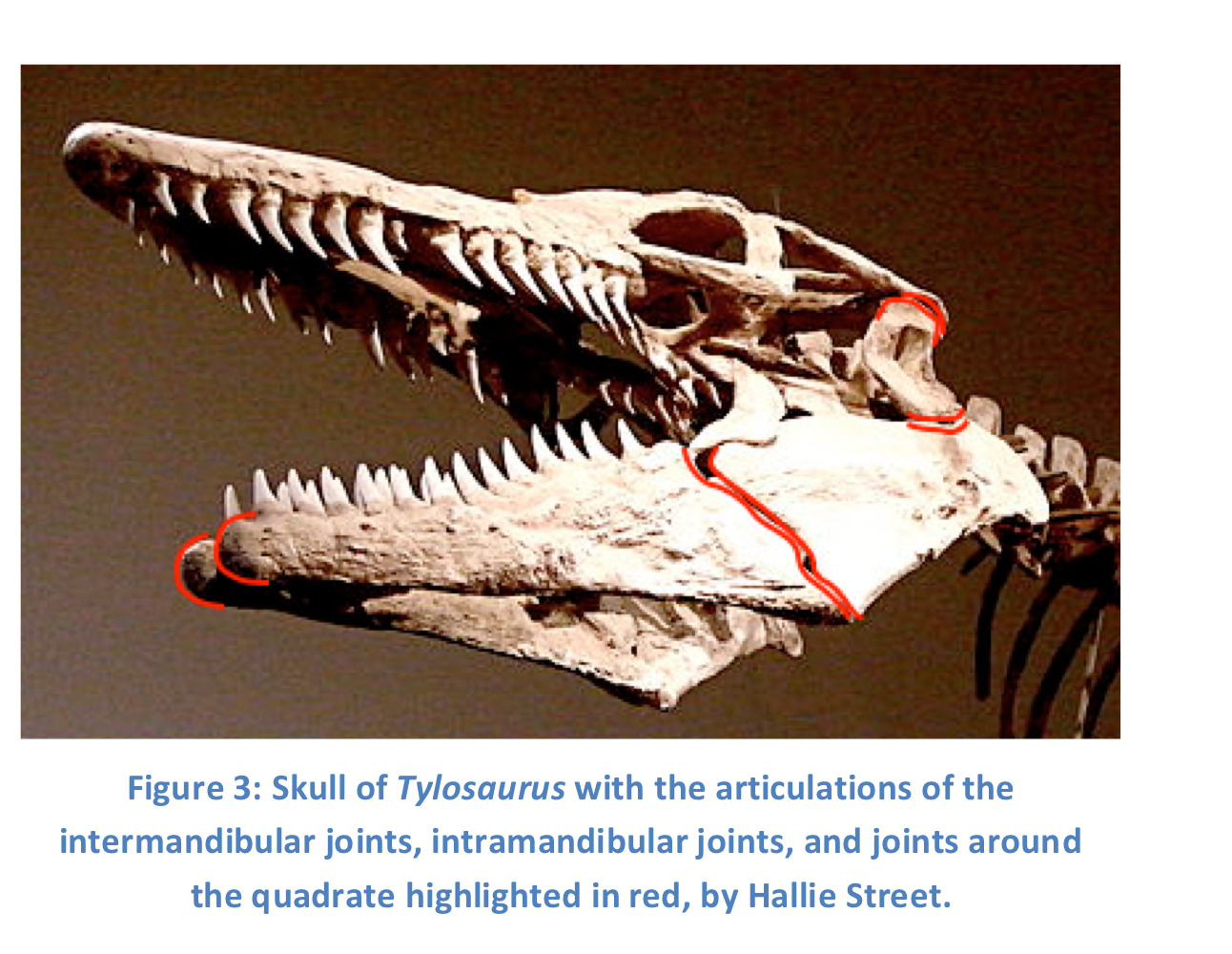
Intermandibular joint
The connection point between the two halves of the lower jaw, found at the front of the mouth. 2 sides of lower jaw did not fuse, held together by soft ligaments, allows two sides of jaw to separate slightly